
A water level monitor can read how much water is in a particular location. It can provide feedback data to data analysts who can see if the water is at a high level, normal level or a low level. There are many different applications where it is helpful to know the level of water beneath the surface or in a remote location which is not easily accessible. One person can simultaneously keep track of any issues in multiple locations by placing water monitoring stations in different areas and collecting the data remotely.
Common applications
Water level monitoring is used daily in many applications and areas you might not even realise. Here are just a few of the ways that water level monitors are used daily in a number of different industries.
Vehicle fuel tank
Take your petrol tank as an example; within the tank, there will be a system that monitors the level of fuel you have left. The information is then returned to your car and displayed on your dashboard as a reading. A light or indicator can also display when your fuel gets too low, and you need to go and fill up. If this weren't in place, you would need to estimate how much fuel you had left and hope that you don’t forget to fill up. Many motorists would regularly run out of fuel and require rescuing, or you would need to keep a spare canister of fuel in the boot.
Landfill leachate monitoring
Another application of a water level monitor is leachate monitoring. Leachate is the water that a landfill produces when organic material breaks down within the landfill site. Leachate is very harmful to the environment and must be carefully collected, treated and disposed of in the right way. A water level monitoring system is used within the leachate collection tank to identify when there is enough leachate to pump out and start the treatment process. The amount of leachate produced by a landfill site varies significantly and cannot be predicted. The substances that are thrown away, and the temperature has an impact on the amount of leachate each landfill produces. A water level monitor is essential to avoid leaks if too much leachate is produced.
Flood detection
Flood detection is a critical application of a water level monitoring system. Predicting floods by monitoring water levels is an essential part of environmental management. When floods occur, they can cause severe damage to homes and wildlife. The data collected from a water level monitor can help to warn residents before a flood. This warning may prevent injury and give people time to take precautions and evacuate the area if needed. Water level monitors in this application can help to save lives. Local authorities will also use the data and predictions to close roads and put measures in place to reduce the impact of the floodwater.
Sewer monitoring
Sewage contains harmful bacteria and chemicals that could lead to disease and death if allowed to overflow. Sewer levels must be carefully monitored to avoid sewage water escaping into the streets and polluting the soil. Water level monitoring systems are used to check the sewer levels continuously. If the levels become too high, measures can be put in place to stop sewage spillages. If sewers were to leak out into the soil, the bacteria could find its way back into the food chain through the growth of crops. Therefore, it is incredibly important to make sure that sewers contain the right level of wastewater.
Groundwater level monitoring
Groundwater is the water that sits below the surface of the ground. Groundwater is used for various applications, including providing drinking water, growing crops, and in a number of different industries. Groundwater collects in large pools called aquifers; if these aquifers become dry and there is no water left, it can take a long time to replenish the water supplies. Groundwater level monitors are needed to prevent issues with groundwater supplies depleting. All businesses and industries that use groundwater as part of their process should be monitoring the levels carefully to avoid running out of water. If all groundwater supplies were depleted, it could be a disaster for much of the world.
